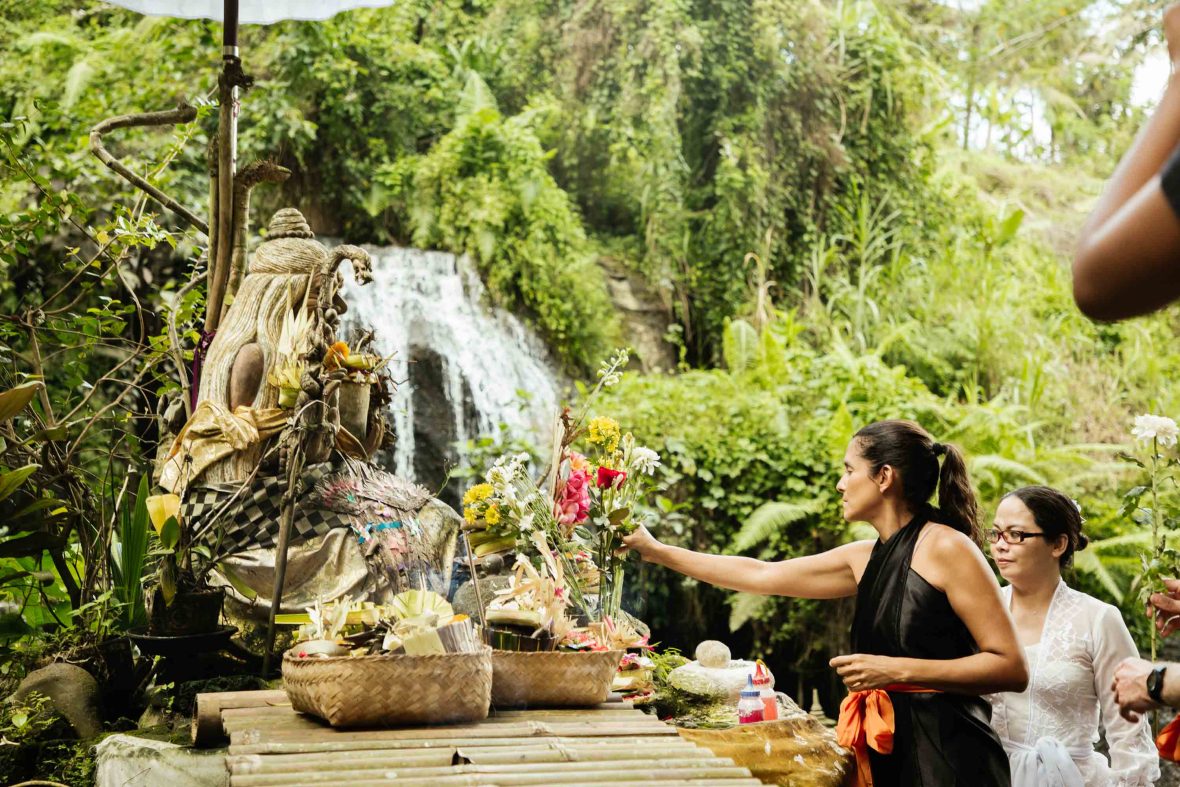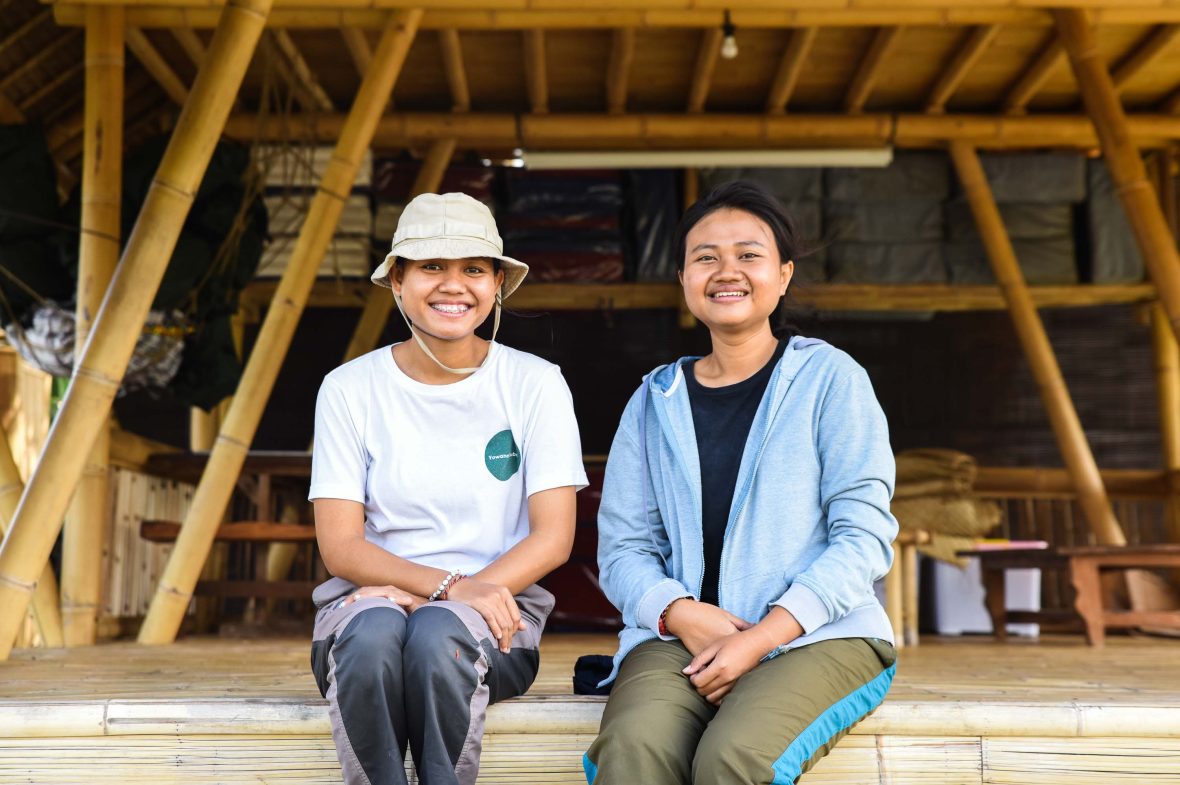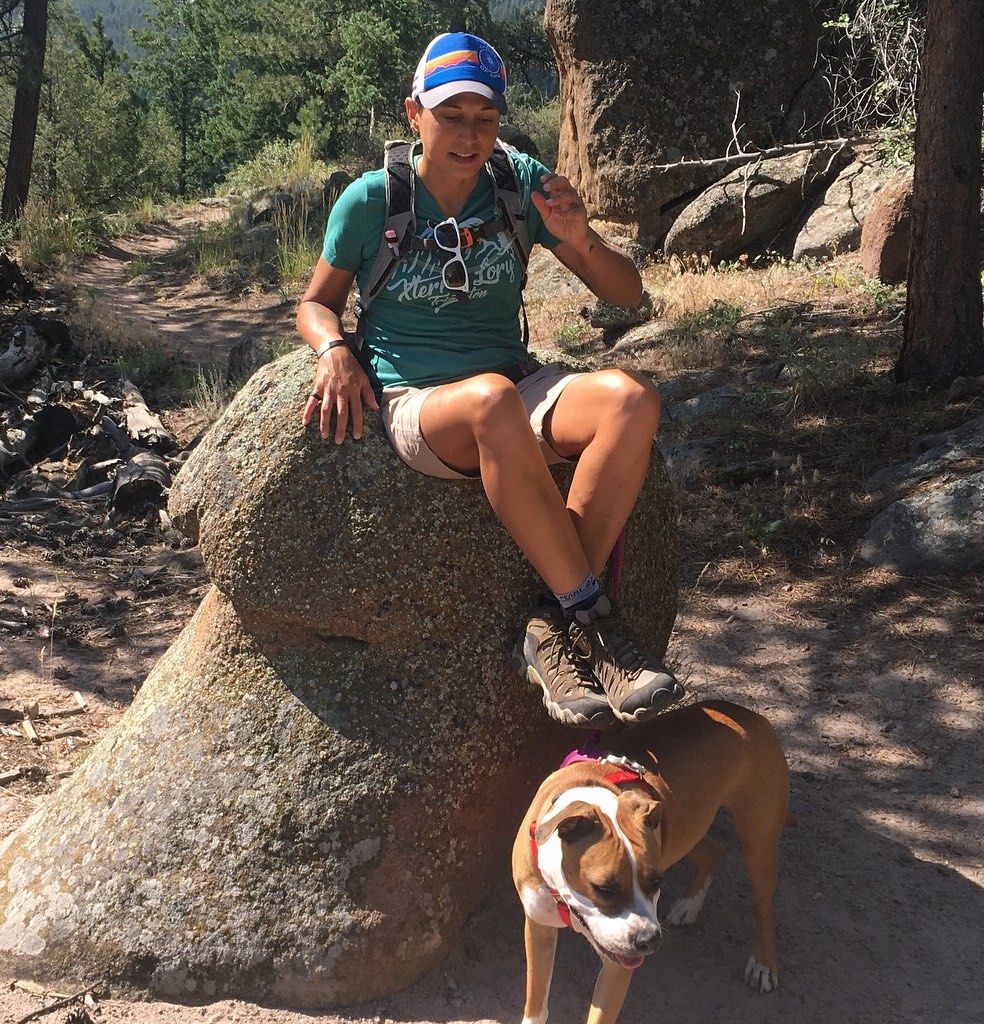
Like an eco-conscious version of Spain’s Camino de Santiago pilgrimage, Bali’s new hiking trail is not only a different way to explore Bali, but it’s part of a broader initiative to teach locals regenerative agriculture.


Like an eco-conscious version of Spain’s Camino de Santiago pilgrimage, Bali’s new hiking trail is not only a different way to explore Bali, but it’s part of a broader initiative to teach locals regenerative agriculture.
My right sneaker is caked in mud and has crushed several seedlings. As Ming and Widya laugh at my plight, I apologize both for the damage and my startling yell as I slip on the narrow ridge we’re treading between rice fields in southern Bali. If I can’t handle such basic terrain, I tell these young Balinese women with a grin, I’d surely embarrass myself on their 132-kilometer-long Astungkara Way.
This 10-day hike, launched in 2020 and led by locals including Ming and Widya, is not designed as a gruelling physical challenge though. Instead, tourists forage, learn farming skills, and are taught bamboo weaving along the trail, which passes verdant rainforest, dramatic valleys, and jungle-draped peaks from Pererenan beach on the south coast to Seririt beach in the north.
Hikers also enter Bali’s spiritual realm. They explore timeworn Hindu temples, visit a 700-year-old sacred tree, join a water purification ceremony at Taman Beji Griya waterfall, and perform Balinese prayer rituals at either end of the trail. Along the way, hikers bring income to small Balinese communities by eating in local homes, sleeping in homestays, and doing lessons in cooking, crafts and foraging.
As we sit inside Astungkara Way’s headquarters, a two-storey, open-air, bamboo building, Ming and Widya point to the surrounding paddies where tourists learn about the rice cycle, from seed to table. This is also the starting point of their shorter, five-day hiking trail, a place called Subak Uma Lambing, 16 kilometers northeast of tourist hub Seminyak.

In every direction are Balinese men and women bent over in fields that stretch to the limit of our sight. Subak Uma Lambing is a cooperative of 250 farmers, many of whom now practise agricultural techniques they were taught at Astungkara Way’s two regenerative farming learning centers.
One center is right here, and the other is 25 kilometers north in Angsri. At these properties, tourists without time to complete the pilgrimage can do half-day farm tours, two-day agriculture experiences, or set out on condensed, three-day versions of the trail.
Meanwhile, on the trail itself, hikers see how to create a composting facility at Jiwa Community Garden, and visit a dragon fruit farm to discover the ‘chop and drop’ technique, where leaves and branches are left to fall on the ground and become mulch.
Throughout the pilgrimage, tourists learn to forage, identifying wild plants which can be used for everything from cooking to making medicines and organic beauty products. Milk from Bali’s ubiquitous coconuts are a key ingredient in organic sun cream. Cloves are plucked from trees and consumed as pain relief. Cat’s Whiskers herb adds a minty zest to tea and is believed to have anti-inflammatory properties. And, while we wandered Astungkara Way’s large flower garden, Ming explained how Hibiscus flowers can add fragrance to natural lotions.
Participants in the hike are also taught about subak irrigation. Dating back to the ninth century, subak is a giant network of canals that funnels waters from its mountains down through Bali’s plains to its coastline, explains Astungkara Way co-founder Tim Fijal, a former schoolteacher from Canada. He was assisted by French permaculture expert Tanguy Yu who helped him establish the route, and the trail was scouted by Balinese staff Oca and Eci.
Fijal, who moved to Bali in 2012, says he conceived of Astungkara Way during nine years at Green School Bali, where he founded Kul Kul Connection, an upcycling program which sees students make costumes from discarded raw materials. In that period, he also began working with local farmers to help them tackle environmental issues.
“For the past 25 years, Bali has lost one percent of its agricultural land annually to development, mostly due to tourism. And starting about 50 years ago, the green revolution reached Bali with its promise of greatly improved production through GMO seeds and chemical inputs to increase yields and combat pests.”
- Tm Fijal, trail founder
“I was touched by the determination of local farmers despite challenging circumstances,” he said. “From farming rice with them and listening to their stories, we learned of their concern for the degradation of soil quality.”
He began a regenerative rice farming program at the Green School, and that snowballed into the larger Astungkara Way, which got off the ground thanks to funding from the International Red Cross and Red Crescent Movement charities.
Underpinning the ethos of Astungkara Way is the Balinese concept of Tri Hita Karana. This philosophy, which has shaped Balinese society for more than a thousand years, refers to harmony with God, harmony among people, and harmony with the environment. It is embedded in Bali’s elaborate Hindu rituals, its social hierarchies, complex temple designs, and traditional environmental practices.
Along the hiking trail near Astungkara Way’s headquarters, Widya shows me a physical example of Tri Hita Karana. Inside a small stone lantern, perched at the edge of a rice field, we find a canang sari. This is a coconut leaf bowl of flower petals left as a gift to Bali’s Hindu deities.
When I lean in to take a closer look, I detect the faint but sweet scent of the incense sticks burned in this custom. During the Astungkara Way hike, participants can take part in this daily Balinese ritual of offering canang sari to the gods in exchange for good fortune.
But the delicate balance represented by Tri Hita Karana has been disturbed by tourism, Fijal warns. Bali is home to only 4.2 million people, yet prior to the pandemic received 6 million tourists a year. At that stage, about 8 percent of Balinese people were working in tourism, which dominated the island’s economy.

Bali’s forests and fields are continually replaced by new hotels, restaurants and resorts. “For the past 25 years, Bali has lost one percent of its agricultural land annually to development, mostly due to tourism,” Fijal says. “And starting about 50 years ago, the green revolution reached Bali with its promise of greatly improved production through GMO seeds and chemical inputs to increase yields and combat pests.
“The unintended results of this revolution have been soil depleted of its natural nutrients that we need to grow healthy food, a staggering loss of biodiversity, polluted air and water, and damaged coral reefs and ecosystems due to chemical run-off. “
“It makes me realize that one of the things that balances our life is agriculture. It’s only when I’m in the field that I feel truly connected with nature and my Balinese heritage.”
- Ni Ketut Widya Astuti
The solution, Fijal says, is the adoption of regenerative agriculture. This is a style of pesticide-free farming that aims to restore soil fertility, increase water percolation, and limit carbon emissions. Complicating matters, however, is the fact most Balinese farmers are aged over 60.
It’s an occupation that’s become increasingly unpopular with Bali’s youth. While Astungkara Way’s hike is aimed at tourists, it is linked to an initiative luring young Balinese people back to farming, and teaching them regenerative agriculture.
Astungkara Way now employs about a dozen locals. They tend its farm and manage its tourism experiences with help from Fijal, and Czech expat Lucie Chmelová, who runs marketing and sales. These Balinese staff have key roles which range from permaculture specialist, to lead farmer, trail customer experience manager, head of administration and operations, and head of farm experiences.
They include 25-year-olds Ming and Widya. Ming, whose full name is Ni Nyoman Aryaningsih, has been with Astungkara Way since the beginning. As she dug her hands into soil, swatted flies from her face, and traipsed through mud to show me their freshest crops, Ming was treading territory many of her friends would not.
She says most Balinese people her age greatly prefer to work in the clean and cool environment of an office, hotel or restaurant. Ming, however, plans to build a career in regenerative farming. “I see an opportunity for myself to grow, to be better at not only knowing new things but also improving leadership skills, and of course, I want to get more experiences in farming,” she says.
So, too, does Ni Ketut Widya Astuti, or Widya, who joined Astungkara Way after completing a university degree in agriculture. She sees herself as a leader of Bali’s next generation of farmers, with a responsibility to create food security for her community. “It makes me realize that one of the things that balances our life is agriculture,” Widya says about working at Astungkara Way. “It’s only when I’m in the field that I feel truly connected with nature and my Balinese heritage.”

This island’s spectacular natural bounty entrances those who complete the hike, Fijal says. What makes this pilgrimage unique, however, is how it lets tourists interact with Balinese people away from the inauthentic environments of hotels, restaurants and shops.
Instead, participants learn from locals in the intimate settings of their houses and farms, and spend the night in comfortable but basic homestays. “This is the antidote to mass tourism, one that offers the traveler insights into the priorities and challenges of local people,” Fijal says.
While we stroll a lush garden at Astungkara Way, enveloped by a palette of natural colors, Widya and Ming tell me this cultural exchange has been an unexpected highlight of working here. They have cherished trading opinions, jokes and wisdom with tourists from countless countries, religions and ethnicities. “We have a lot of fun—this whole project is about fun and learning new skills with new people,” Widya says, beaming.
And it is all linked, directly or indirectly, to farming. An occupation that’s lost favor in Bali, but one which the Astungkara Way hopes to revive.
***
Adventure.com strives to be a low-emissions publication, and we are working to reduce our carbon emissions where possible. Emissions generated by the movements of our staff and contributors are carbon offset through our parent company, Intrepid. You can visit our sustainability page and read our Contributor Impact Guidelines for more information. While we take our commitment to people and planet seriously, we acknowledge that we still have plenty of work to do, and we welcome all feedback and suggestions from our readers. You can contact us any time at hello@adventure.com. Please allow up to one week for a response.

Fascinated by the cultural heritage of places near and far, Ronan is a travel journalist and photographer with 19 years’ experience. After a long career at daily newspapers in Australia, Ronan’s traveled to 60+ countries and has bylines in National Geographic, BBC, CNN, Forbes, The Guardian, Travel + Leisure, Conde Nast Traveler and Lonely Planet.








Can't find what you're looking for? Try using these tags: